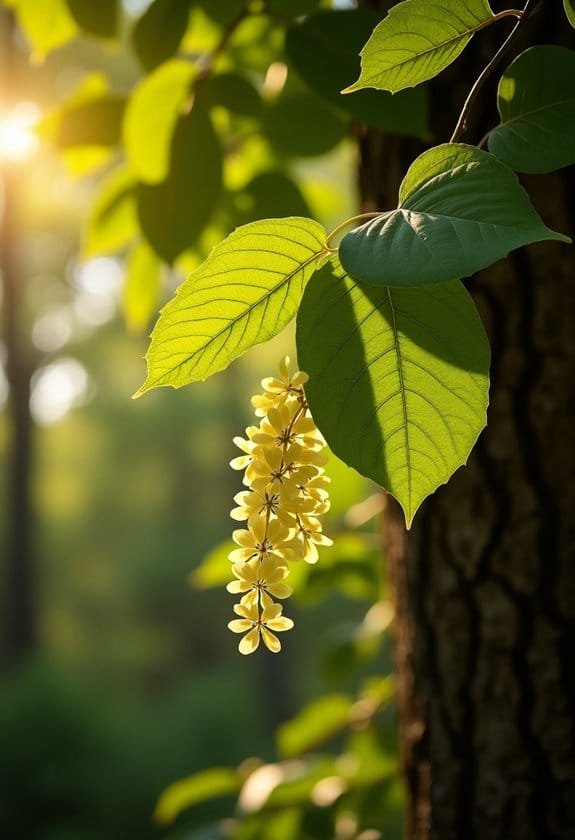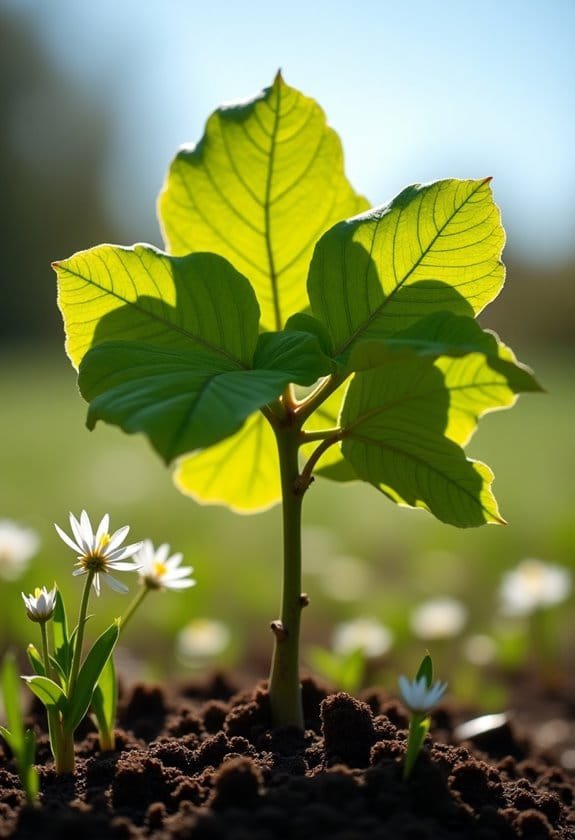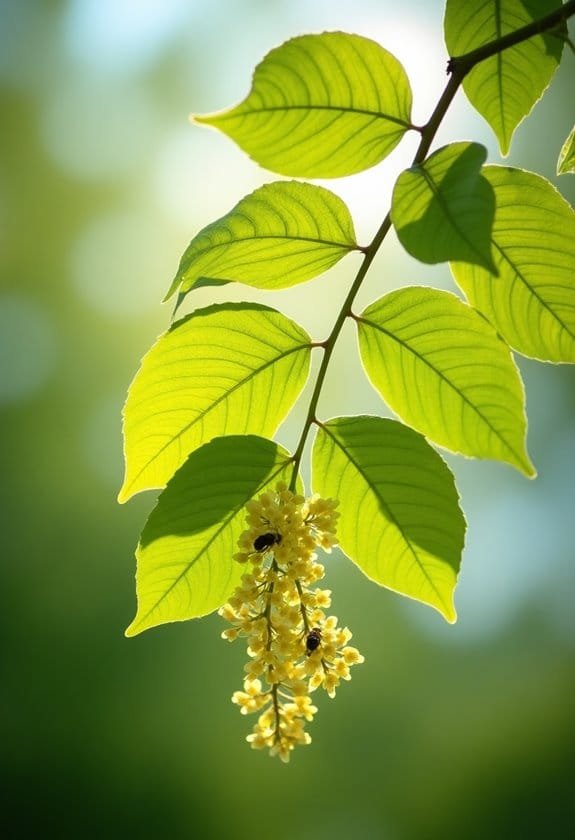Tilia oliveri, or Oliver's Lime, stands out as a remarkable tree known for its ecological benefits and aesthetic appeal. Reaching heights of up to 26 meters, it features semi-weeping branches and heart-shaped leaves, measuring 5-11 cm. Flourishing in China's mountainous regions, this species thrives in well-drained soils and requires consistent moisture, particularly during its formative years. Its fragrant, nectar-rich flowers attract crucial pollinators like bees and butterflies, contributing to urban biodiversity. Despite its resilience, Oliver's Lime faces challenges such as root rot from poor drainage. Exploring its unique traits reveals further insights into its cultivation and ecological significance.
Main Points
- Tilia oliveri, or Oliver's Lime, is a tree native to China, thriving in mountainous regions like Gansu and Hubei.
- It grows up to 26 meters tall, featuring semi-weeping branches and distinctive heart-shaped leaves.
- The tree's mid-summer flowers attract pollinators like bees and butterflies, enhancing local biodiversity.
- Oliver's Lime requires well-drained soil and consistent moisture, especially during its early growth stages.
- While classified as Least Concern, it faces challenges like root rot and urban pollution, affecting its health.
Introduction

Tilia oliveri, more commonly known as Oliver's Lime or Oliver's Linden, stands as a remarkable species first introduced to Western horticulture by Ernest Wilson in 1900.
This elegant tree, capable of soaring up to 26 meters tall, showcases semi-weeping branches adorned with unique foliage that captivates the eye.
Thriving in China's mountain forests, particularly in regions like Gansu and Hubei, it's not only resilient to aphid infestations but also attracts a wealth of pollinators with its fragrant mid-summer blossoms.
Common Name
Known commonly as Oliver's Lime or Oliver's Linden, Tilia oliveri reflects its unique characteristics and taxonomy through these names. Discovered in 1888 by the botanist Augustine Henry, this remarkable species was later introduced to Western cultivation in 1900 by Ernest Wilson.
Oliver's Lime boasts elegant, semi-weeping branches that create a picturesque silhouette, complemented by its broad, finely-toothed leaves—dark green above and silvery white beneath.
The tree is particularly celebrated for its sweetly-scented white flowers that bloom in mid-summer, creating a fragrant oasis that attracts various pollinators, including bees and butterflies. These pollinators are crucial for maintaining urban biodiversity, demonstrating the ecological benefits of Tilia oliveri in city landscapes.
While its aesthetic appeal enchants many gardeners and landscapers alike, Oliver's Linden serves a dual purpose by enhancing the habitat for local wildlife.
This synergy between beauty and environmental support positions Tilia oliveri as an invaluable addition to urban forestry, contributing positively to both the aesthetic and ecological dimensions of the environments it inhabits.
Through its graceful presence, Oliver's Lime indeed embodies the intersection of human enjoyment and nature's essential rhythms.
Scientific Name
The scientific name for Oliver's Lime, Tilia oliveri, is proof of its distinctive characteristics and heritage. First discovered in 1888 by renowned botanist Augustine Henry, this tree has garnered significant attention due to its unique attributes and adaptability within its native habitats.
Tilia oliveri thrives in the mountain forests of Central China, specifically across provinces like Gansu, Hubei, Hunan, Shaanxi, and Sichuan, where it flourishes among diverse flora.
Classified under the Malvaceae family, Tilia oliveri exhibits a striking appearance, marked by semi-weeping branches and large floral bracts that complement its lush foliage.
The undersides of its leaves are densely covered with a whitish tomentum, contributing to its overall aesthetic and ecological value. This charming tree species stands apart with its classification under the authority of Szyszył., emphasizing its unique taxonomic status among lime trees.
As researchers and enthusiasts explore the myriad qualities of Tilia oliveri, they recognize the importance of its preservation and cultivation, allowing future generations to appreciate its beauty and ecological significance.
Overview
Oliver's Lime, scientifically referred to as Tilia oliveri, stands out as an impressive broadleaf deciduous tree, reaching heights of up to 26 meters. Native to the sheltered mountain forests of China, this remarkable tree has been cultivated in Europe since its introduction in 1900 by the renowned botanist Ernest Wilson. Its distinctive foliage features broadly ovate leaves that exhibit dark green upper surfaces, complemented by densely covered white tomentum underneath, creating a striking visual contrast.
In addition to its aesthetic appeal, Tilia oliveri offers considerable ecological benefits. The tree's semi-weeping branches provide habitat for a variety of bird and insect species, fostering biodiversity in urban and natural landscapes. Moreover, Oliver's Lime contributes to air quality improvement and soil stabilization through its extensive root system.
As the seasons change, Tilia oliveri enchants observers with its large, pale green, hairy floral bracts, which eventually develop into ellipsoidal fruits, adorned with brown tomentum.
With such unique characteristics and ecological contributions, Oliver's Lime deserves recognition not just for its beauty, but also for its essential role in sustaining healthy ecosystems in both urban and natural environments.
Key Features
Tilia oliveri, or Oliver's Lime, impresses with its remarkable growth size, reaching heights of up to 26 meters.
Its semi-weeping branches and distinctive leaves, broadly ovate to orbicular at 5–11 cm, create an elegant silhouette, while the pale green, hairy floral bracts, measuring 6–11 cm, enhance its visual appeal during the flowering season.
This enchanting species not only enriches urban landscapes but also supports biodiversity by attracting essential pollinators with its fragrant blooms.
Growth Size
With a mature height reaching up to 25 meters, Tilia oliveri showcases a remarkable growth potential. This species, popularly known as Oliver's Lime, can achieve about 10 meters in height and 4 meters in width after 25 years of growth. Its impressive growth size makes it a compelling choice for both urban landscapes and private gardens.
The tree develops a distinctively dome-shaped canopy, accompanied by semi-weeping branches that create an elegant silhouette against the skyline. The heart-shaped, broadly ovate leaves are another striking feature, dark green above while showcasing a densely covered white tomentum beneath.
This combination adds to the overall visual appeal of Oliver's Lime, making it a desirable addition to any planting scheme.
Tilia oliveri thrives in various soil types and demonstrates resilience against environmental stresses. While it prefers evenly moist conditions, the tree exhibits a notable capacity to tolerate slightly drier conditions once established.
The adaptability of Oliver's Lime contributes considerably to its remarkable growth, allowing it to flourish and provide shade in diverse settings while enhancing biodiversity.
Appearance
A striking feature of Tilia oliveri is its light grey bark, which develops shallow longitudinal fissures as the tree matures, especially noticeable around the age of 100 years. This visually appealing characteristic adds a rustic charm to the landscape.
The tree reaches heights of up to 26 meters, but it typically stabilizes around 25 meters, creating a broadleaf canopy that provides substantial shade.
The leaves of Tilia oliveri are another significant aspect; they're broadly ovate to orbicular, measuring 5–11 cm in length and 5–10 cm in width. The upper surface showcases a rich mid-green hue, while the undersides are densely covered with fine, soft white tomentum, creating a striking contrast.
These features enhance the tree's overall attractiveness to insects, drawing them in with their texture and shade.
Additionally, the tree boasts large floral bracts, which measure 6–11 × 0.9–2.5 cm, featuring a pale green hue with a hairy texture that contributes to its ornamental appeal.
The ellipsoidal fruits, ranging from 9–14 mm in length and 7–10 mm in width, are also densely covered in brown tomentum, further accentuating the unique physical traits of this magnificent species.
Flowering Season
In mid-summer, Tilia oliveri bursts into bloom, producing an abundance of sweetly-scented white flowers that attract various pollinators, including bees and butterflies. This impressive display typically occurs when conditions are lush and leafy, as the tree thrives in environments with full sun to mostly shaded areas, coupled with regular moisture.
The large flowering bracts, ranging from 6 to 11 centimeters in length and 0.9 to 2.5 centimeters in width, present a pale green, hairy texture, guiding the eye toward the delicate clusters of small flowers within. Each cluster, rich in nectar, entices numerous insects, promoting effective pollination, which ultimately leads to seed development.
During the flowering season, Tilia oliveri plays a significant ecological role by providing essential habitat and sustenance for pollinators. This mutualistic relationship enhances local biodiversity, as the sweetly-scented flowers not only sustain the immediate ecosystem but also foster growth and interaction among various species.
Growing Requirements

Tilia oliveri flourishes under a wide range of light conditions, from full sun to dappled shade, making it a versatile addition to diverse landscapes.
It thrives in various soil types, enduring both light and heavy compositions, while its remarkable ability to tolerate temporarily saturated soils enhances its adaptability.
To establish robust growth, consistent moisture, especially during the vital first summer, proves essential; once settled, these trees can withstand drought, yet they still appreciate even moisture throughout their growing season.
Light
Full sun to mostly shaded conditions suit Tilia oliveri well, offering flexibility for gardeners. This lime tree thrives across various light exposures, from bright sunlight to dappled shade.
Ideally, it requires regular moisture, particularly during its establishment phase, to encourage robust growth. The tree's adaptability allows it to flourish in average soil conditions while benefiting from filtered light.
In gardens where direct sunlight may be intense, providing some shade can enhance the tree's resilience and overall health. Dappled shade plays a significant role during the growing season, helping to maintain moisture levels that Tilia oliveri craves.
Once established, this species demonstrates remarkable drought tolerance, but it still appreciates the moisture that shade provides, especially in hotter climates.
Moreover, Tilia oliveri's semi-weeping branches necessitate protection from strong winds, as they can be sensitive to harsh weather conditions. Consequently, selecting the right location, whether sunny or partially shaded, mightn't just support ideal growth but also shield the tree from potential damage.
Balancing light, moisture, and protection guarantees that Tilia oliveri thrives beautifully in diverse garden environments.
Soil
Soil quality plays a critical role in the healthy growth of Tilia oliveri. Known as the Chinese white lime, this species demonstrates remarkable adaptability, thriving in diverse soil types, including both light and heavy soils, as well as chalk and clay compositions.
However, it prefers well-drained soils, a preference emphasized by the renowned plant explorer, Ernest Wilson, who championed its cultivation.
While Tilia oliveri can withstand temporarily waterlogged conditions, excessively dry environments can seriously hinder its development. Regular moisture during the growing season is essential, particularly for young trees as they establish their roots.
Too little water can impede growth, underscoring the significance of selecting a suitable planting location that balances moisture levels.
Planting Tilia oliveri in poorly-drained or consistently soggy soils can lead to devastating consequences. The tree's vigor diminishes when its roots sit in stagnant water, stifling their ability to absorb necessary nutrients.
Ultimately, choosing well-drained sites not only enhances Tilia oliveri's growth potential but also fosters resilience against environmental stresses. Proper soil considerations serve as the foundation for nurturing this beautiful species.
Water
Maintaining consistent moisture is imperative for the healthy growth of Tilia oliveri. This species flourishes in moist soil, which provides the adequate hydration needed for its development. However, it's essential to avoid waterlogged conditions, as excess water can lead to detrimental root rot.
During the initial summer following planting, regular watering is paramount; diligent attention to moisture levels helps establish a robust root system crucial for long-term growth.
Tilia oliveri prefers dappled shade to full sun environments, which play a significant role in preserving optimal soil moisture levels. Once the tree is firmly established, it showcases impressive drought tolerance, allowing it to require less frequent watering during dry spells.
This adaptability makes Tilia oliveri suitable for various urban and garden settings, where fluctuations in rainfall may occur.
Understanding the balance of watering is key; while these trees thrive in evenly moist soil, their ability to withstand short periods of drought offers a remarkable resilience.
Temperature
Tilia oliveri thrives in USDA Hardiness Zone 6, which means it can handle temperatures as low as -10°F (-23°C).
This species prefers conditions that maintain even moisture, which is essential for its health amid temperature fluctuations, especially during warmer months. The tree flourishes in full sun to mostly shaded areas and requires regular watering during its first summer. This initial care guarantees the establishment of a strong, healthy structure.
Importantly, Tilia oliveri can tolerate temporary soaking conditions, allowing it to adapt to diverse moisture levels within its temperature range.
Once established, its remarkable drought tolerance becomes evident, enabling it to endure periods of reduced moisture while still maintaining robust, aesthetic foliage. This resiliency is a significant characteristic, as it guarantees the tree remains vibrant even during dry spells, a quality that enhances its appeal in various landscapes.
Pollinator Criteria
Tilia oliveri, renowned for its mid-summer bloom, draws an impressive array of pollinators, particularly bees and butterflies, with its large, white, sweetly-scented flowers.
The tree's small flowers, which flourish on hairy, pale green bracts measuring 6–11 cm, rely heavily on insect pollination, effectively enriching biodiversity within their local ecosystems.
This interaction not only highlights the tree's ecological significance but also underscores its role in supporting vibrant habitats, fostering healthy pollinator populations year after year.
Attracted Pollinators
Attracting a variety of pollinators, Tilia oliveri thrives during the peak of the pollination season with its fragrant, white flowers. Blooming in mid-summer, these abundant flowers emit a sweet scent that lures in numerous insect species, particularly bees and butterflies. This strategic timing guarantees that pollinators find a crucial food source just when they need it most.
The flowers of Tilia oliveri are complemented by large floral bracts, measuring 6–11 × 0.9–2.5 cm, which serve as excellent landing platforms for pollinators. This structural feature facilitates easy access to nectar, maximally supporting the foraging efforts of these essential insects. By fostering such diversity among pollinators, Tilia oliveri asserts itself as an indispensable player in promoting local biodiversity.
Moreover, its natural resistance to pests, including aphids, results in minimal honeydew production, maintaining a clean environment for pollinators to thrive.
This interconnected relationship not only bolsters the health of insect populations but also contributes to the overall robustness of surrounding ecosystems, highlighting the importance of Tilia oliveri in ecological balance.
Pollination Method
Pollination of Tilia oliveri relies heavily on a diverse array of insects, particularly bees and butterflies, that are drawn to its fragrant blooms. The tree's finely toothed leaves complement its small flowers, creating an inviting environment for these essential pollinators. During mid-summer, when Tilia oliveri is adorned with vibrant, fragrant clusters, insect pollination becomes crucial for successful reproduction.
The floral arrangement, featuring large hairy bracts, not only enhances visibility but also provides accessibility for insects seeking nectar. These adaptations serve to maximize the chances of effective pollination, which is fundamental for seed development. The presence of healthy, active pollinators greatly influences the overall success of pollination events, enabling the tree to thrive in both native and cultivated habitats. Furthermore, Bird Cherry (Prunus padus), as an early-season nectar source, also supports pollination efforts during spring months.
Moreover, the importance of maintaining robust populations of these insects can't be overstated. Without a rich diversity of pollinators sharing their resources in a harmonious ecosystem, the delicate balance required for Tilia oliveri's propagation would suffer.
Therefore, fostering environments conducive to insect activity guarantees the continued existence of this tree, with its lush dark green foliage and aromatic flowers enriching the landscape. Additionally, the bright pink-to-purple flowers of other flowering plants, such as common mallow, also contribute significantly to attracting pollinators, supporting ecosystem stability and biodiversity.
Care & Maintenance

Understanding how to properly care for Tilia oliveri is vital for its thriving presence in gardens and urban landscapes.
It's important to guarantee consistent moisture and proper soil conditions to support robust growth, while strategic pruning can enhance the tree's shape and overall vigor.
Selecting suitable companions can further enrich the planting environment, fostering a harmonious ecosystem that promotes sustainability and beauty.
Planting Tips
Planting Tilia oliveri successfully hinges on selecting the right location and ensuring proper care. Gardeners should aim for a location that provides full sun to mostly shade, ideally offering dappled light during warmer months. This balance fosters robust growth, allowing the tree to thrive and flourish.
When it comes to soil, using well-draining soil is fundamental, as this species can suffer in waterlogged conditions that hinder root development.
For ideal establishment, regular moisture is essential, particularly during the first summer. Frequent watering will help young trees adapt to their environment, supporting healthy growth and reducing stress.
Additionally, while Tilia oliveri benefits from pruning to maintain its shape, it's important to avoid unnecessary trimming during its initial few years of establishment. Focus on creating a stable, robust structure before considering aesthetic modifications.
Ongoing Care
To guarantee that Tilia oliveri remains healthy and vibrant, ongoing care and maintenance are essential. Young trees particularly require regular watering during their first summer to establish robust root systems. This significant period guarantees that moisture penetrates the soil effectively, fostering the necessary conditions for growth.
Pruning isn't immediately required after dispatch, but it can be beneficial later on for maintaining shape and promoting healthy development; judicious trimming encourages denser foliage and prevents overcrowding.
Additionally, it's crucial to verify that its planting site avoids frozen or waterlogged conditions, especially for bare root trees, as this enhances survival rates. Tilia oliveri demonstrates impressive adaptability to various soil types, yet it should be shielded from excessively dry environments and harsh winds to maximize its health and well-being.
Those nurturing container trees must repot them into larger vessels promptly, as this step prevents root binding and supports sustained growth. By carefully balancing watering needs, strategic pruning, and suitable soil management, caretakers can cultivate a flourishing Tilia oliveri that thrives in its environment, showcasing its grandeur for many seasons to come.
Moreover, maintaining healthy soil conditions through soil moisture monitoring is essential for optimal tree health and growth.
Suggested Companions
Selecting the right companion plants for Tilia oliveri can greatly enhance the health and beauty of your garden. Ideal companions should be shade-tolerant species that thrive in dappled sunlight and well-drained soil, creating a harmonious ecosystem beneath the linden tree's expansive canopy.
Plants such as hostas and ferns are particularly appealing, as they complement Tilia oliveri's lush foliage, enhancing the aesthetic without competing for light. Additionally, these companion plants can benefit from the proximity of male and female plants of nearby holly species, which may improve pollination in the area.
Incorporating flowering perennials like astilbes or bleeding hearts not only promotes biodiversity by attracting pollinators like bees and butterflies but also adds vibrant pops of color throughout the growing seasons.
It's important to select species that share similar hardiness zones, ideally Zone 6 or lower, ensuring compatibility in environmental conditions. Additionally, planting evergreen shrubs such as Buxus sempervirens can provide year-round structure and interest to the garden while also contributing to a resilient ecosystem.
Maintenance practices, such as mulching and monitoring soil moisture levels, benefit both Tilia oliveri and its companions, fostering a thriving botanical community.
By emphasizing biodiversity, gardeners can cultivate an ecosystem rich in life and resilience, making the most of their Tilia oliveri while supporting the flourishing relationships among their plants.
Taking these careful considerations into account will help create a harmonious and visually stunning landscape.
Common Issues
Despite Tilia oliveri's remarkable resistance to pests, certain challenges persist that can affect its vigor.
Root rot may occur when the tree is planted in waterlogged soil, emphasizing the need for well-drained conditions, while prolonged drought can lead to leaf drop, particularly during its formative years.
Additionally, urban pollution presents a risk to its overall health, necessitating attentive care to guarantee thriving growth in often challenging environments. Silverweed, with its preference for well-drained sandy soils, highlights the importance of proper soil conditions for maintaining plant health.
Pests/Diseases
Tilia oliveri is largely resistant to common pests, making it a resilient choice for gardeners looking to avoid the nuisances often caused by aphids. This remarkable ability substantially reduces the risk of honeydew production on foliage, which can attract secondary pests and promote sooty mold development.
However, this species can be susceptible to certain leaf spot diseases, especially in circumstances characterized by high humidity or overcrowded planting arrangements. Such conditions may eventually lead to potential defoliation, thereby compromising the tree's health.
Moreover, Tilia oliveri might encounter fungal infections like powdery mildew, frequently flourishing in shaded or poorly ventilated areas. These ailments thrive in environments lacking ideal airflow, thereby illustrating the significance of proper spacing.
To bolster the tree's health, it's crucial for gardeners to guarantee well-planned spacing and regular pruning to enhance air circulation around Tilia oliveri. By diligently monitoring leaves for early signs of disease, individuals can implement timely interventions that minimize disease impact.
This proactive management guarantees the tree maintains robust health, assuring a lush and vibrant presence in gardens while mitigating the risks of common pests and diseases.
Solutions
When dealing with common issues related to Tilia oliveri, gardeners can take several proactive steps to confirm the tree's health and vigor. First and foremost, guaranteeing the tree is planted in well-drained soil plays an essential role in preventing waterlogged roots, which can lead to root rot.
Gardeners should regularly water young Tilia oliveri during the first growing season, allowing the roots to establish themselves effectively—about 1 inch of water per week typically suffices.
Moreover, while Tilia oliveri exhibits resistance to aphids, monitoring for other pests remains prudent. Light maintenance through strategic pruning helps maintain the tree's shape, particularly in older specimens, with hard pruning prompting significant improvements in growth and structure.
The tree adapts well to various light conditions, ranging from full sun to dappled shade, fostering resilience in diverse landscapes. Inspecting the upper surface of leaves for signs of distress can also provide early warning signs of potential issues.
Summary

Oliver's Lime, scientifically known as Tilia oliveri, is a deciduous tree that can reach heights of up to 26 meters. Discovered by Augustine Henry, this remarkable species features elegantly semi-weeping branches adorned with broadly ovate leaves measuring 5–11 × 5–10 cm. The upper surface showcases a mid-green hue, while the lower surface displays a densely covered white tomentum, creating a striking visual contrast that captivates the eye.
In mid-summer, Tilia oliveri produces large, sweetly-scented white flowers that attract an array of pollinators, including bees and butterflies, highlighting its ecological importance. Native to mountain forests in China, the tree flourishes in USDA Hardiness Zone 6, preferring a sheltered environment with regular moisture, rendering it suitable for arboreal and garden settings.
Despite being classified as Least Concern regarding conservation status, this species remains a rarity in North America, with notable specimens housed in various European collections such as those at the Royal Botanic Gardens, Kew.
The International Dendrology community recognizes its significance, further emphasizing the need for broader cultivation and appreciation of Oliver's Lime.


